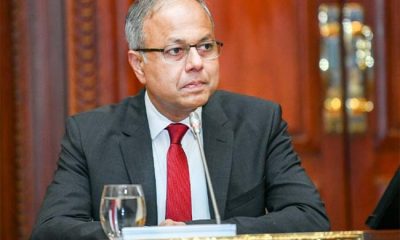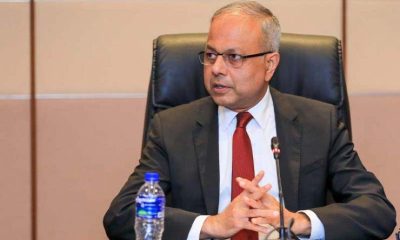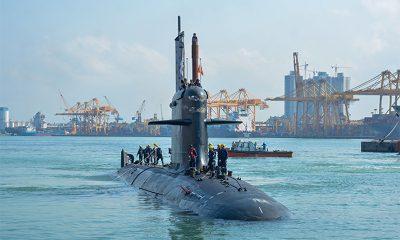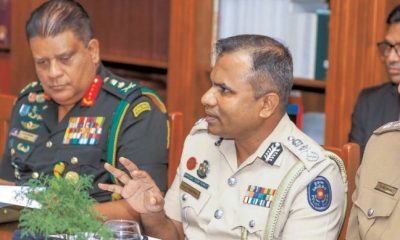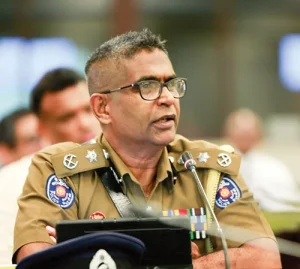Midweek Review
US Indo-Pacific strategy: Impact on bankrupt Sri Lanka
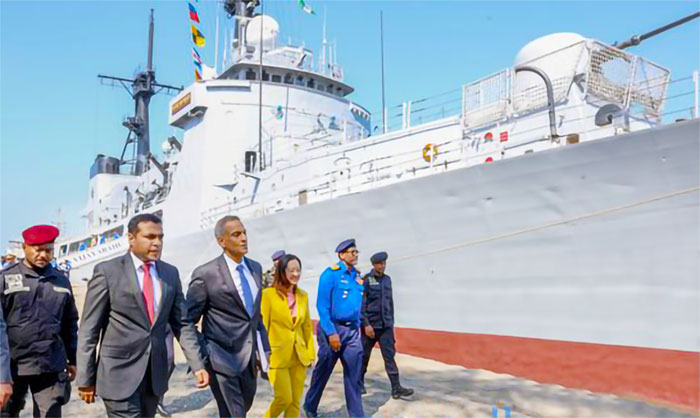
By Shamindra Ferdinando
The US has announced the transfer of decommissioned USCGC Decisive (WMEC 629) to Sri Lanka next year. The US Coast Guard decommissioned the 210-foot vessel after 55 years of service, at a ceremony at Naval Air Station Pensacola, on March 2, 2023. Sri Lanka is scheduled to take delivery of the vessel following necessary modernization to meet SLN’s operational requirements.
Navy headquarters, in a statement dated April 8, 2024, disclosed having preliminary talks with the US regarding the planned transfer of the vessel. According to that statement, the Chief of the Office of Defence Cooperation US Embassy in Colombo, Commander Sean Jin led the talks.
The transfer is likely to take place the year following the presidential poll,expected to be conducted in Sept/Oct this year.
The SLN statement underscored the growing US-Sri Lanka relationship ahead of the presidential polls later this year, and parliamentary polls next year.
Sri Lanka previously took delivery of USCGC Courageous in 2004 (commissioned as SLNS ‘Samudura’/P 621), USCGC Sherman in 2018 (Commissioned as SLNS ‘Gajabahu’ /P 626), and USCGC Douglas Munro in 2021 (Commissioned as SLNS ‘Vijayabahu’ /P 627).
USCGC decommissioned Courageous after 33 years of service whereas USCGC Sherman and USCGC Douglas Munro served the US for 50 and 49 years, respectively.
However, bankrupt Sri Lanka should be aware of the high cost of maintaining decommissioned vessels long past their service life, especially in terms of high fuel consumption. Besides, as pointed out by experts recently, when President Wickremesinghe wanted to deploy our naval assets in support of the US-led operation to protect shipping in the Red Sea, that they would be sitting ducks in this age of missile and drone warfare. It is no secret that Australia earlier paid both our Navy and Air Force for fuel to conduct operations in support of their efforts to block illegal migration, Down Under.
Still silent on Speaker’s declaration
In spite of a controversial travel ban imposed on Chief of Defence Staff (CDS) General Shavendra Silva and his family in Feb 2020, over unsubstantiated war crimes allegations, the US seemed to be keen on further improving relations with Sri Lanka in the wake of President Gotabaya Rajapaksa’s ouster in July 2022. At the time the US declared the travel ban, the celebrated General Officer Commanding (GOC) of Task Force 1/58 Division, which played a crucial role in the final phase of the war, also held the post of Army Commander.
In the wake of the May 09/10, 2022, violence that sent shock waves across the country, then President Gotabaya Rajapaksa replaced General Silva with Vikum Liyanage, promoted to Lt. General’s rank on June 1, 2022.
Regardless of continuing controversy over the US role in President Gotabaya Rajapaksa’s ouster, especially against the backdrop of Speaker Mahinda Yapa Abeywardena’s surprising but much belated declaration of direct external involvement in the violent protest campaign, President Ranil Wickremesinghe’s Office on April 10 divulged US National Security Advisor Jake Sullivan getting in touch with his counterpart here Sagala Ratnayake, the one-time Public Security Minister.
Obviously, the US move is in line with its much touted Indo-Pacific tilt. The US wants Sri Lanka to be part of its developing strategy. Did the US find President Gotabaya Rajapaksa a hindrance to its designs in the region, hence the decision to influence an unprecedented violent public protest campaign that forced the war-time Defence Secretary out of office?
The former President, in his recently launched ‘Conspiracy to oust me from Presidency’ discussed the possibility of how the US threatened action on the human rights front may have discouraged the military from taking tangible measures to neutralize the threat posed by the violent protest campaign.
But, the Wickremesinghe-Rajapaksa government appeared to have chosen to simply ignore Speaker Abeywardena’s confirmation of US involvement, as first disclosed by National Freedom Front (NFF) leader Wimal Weerawansa in late April 2023. A couple of months later, retired Navy Chief of Staff Rear Admiral Sarath Weerasekera, in his capacity as Chairman of the Sectoral Oversight Committee on National Security, confirmed lawmaker Weerawansa’s accusations.
The Bar Association’s pathetic failure to comment on the Speaker’s revelation should be examined against the backdrop of a spate of statements it issued during the public protest campaign and after, in support of those protests. In the wake of fresh controversy caused by former President Maithripala Sirisena regarding the Easter Sunday carnage, the Bar Association urged the former President to make, what it called, a full and honest ,disclosure of any sensitive information he possessed. Withholding such information, as a former head of state, would constitute a serious obstruction of justice,” the Bar Association warned.
Perhaps, the Bar Association should also reveal its stand on the Speaker’s declaration as it cannot be selective in addressing contentious issues.
Change of US strategy
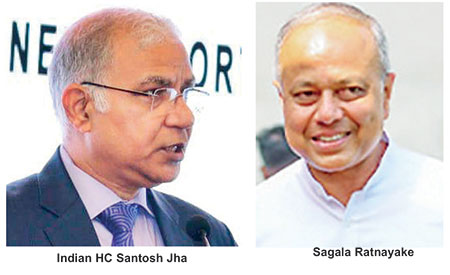 The US seems to have made up its mind to proceed with Wickremesinghe-led Sri Lanka though it appeared to have earlier envisaged an interim administration, under Speaker Abeywardena, sans the former.
The US seems to have made up its mind to proceed with Wickremesinghe-led Sri Lanka though it appeared to have earlier envisaged an interim administration, under Speaker Abeywardena, sans the former.
The Samagi Jana Balawegaya-led Opposition appears to have conveniently forgotten CIA Chief William Burns visit here in Feb 2023, a few weeks before MP Weerawansa alleged US Ambassador Julie Chung’s intervention with Speaker Abeywardena. The US mission in Colombo and the government didn’t confirm or deny the CIA Chief’s visit.
Similarly, there was not a hum from our JVP comrades when the CIA Chief made that clandestine visit to Colombo 14 months ago in the dead of the night after closing off the Colombo-Katunayake expressway to all other traffic. Have they clearly turned into Business suited capitalists now, easily globetrotting like nobody’s business, while the bulk of the masses they have vowed to represent are gasping for breath under these unprecedented economic difficulties? To this day the Sri Lankan public is in the dark as to who or what came in those two giant US aircraft that brought CIA Chief Burns and his equally secretive delegation to Colombo without a word from our government or from Washington DC other than a leak here and there. The JVP-led Jathika Jana Balawegaya, too, remains silent on US interventions here. The JVP has quietly improved its relations with the US over the past few years and now enjoys friendly relations with the Superpower. JVP leader Anura Kumara Dissanayake toured the US in late Oct/early Sept., 2023. AKD toured India in early January and Canada in late March, this year. Therefore, it is not too hard to understand the change in the JVP’s overall approach. Have comrades sold us out to the devil?
Lawmaker Weerasekera was snubbed by Washington by him being denied an opportunity to join chairpersons of 17 Oversight Committees chosen for a 10-day study tour of the US, organized by the National Democratic Institute (NDI) and USAID, in late Oct., 2023. Weerasekera, the former Navy Chief of Staff, retired in late 2006 after having served the Navy with an unblemished record for well over three decades. Obviously, the US found fault with MP Weerasekera for his comments critical of the US, especially in the aftermath of Gotabaya Rajapaksa’s ouster. The SLN veteran was one of the few who wanted to break up the growing protest campaign, while the West, in general, along with the NGOs they fund here, cunningly pleaded that they were peaceful protests and even called on the police and security forces not to use force against them.
Weerasekera quit on April 18, 2022, the day before Rambukkana erupted and at the time countrywide violence exploded on May 9, Prasanna Ranatunga served as Public Security Minister. Among several dozens of properties set ablaze in several parts of the country, were Ranatunga’s in the Gampaha district, the worst affected area.
US Ambassador Chung strongly and repeatedly discouraged the Gotabaya Rajapaksa government from appropriately responding to the growing protest campaign. However, UNP leader Ranil Wickremesinghe, having been elected President on July 20, 2022, by Parliament to complete the term of the ousted President Gotabaya, immediately directed the removal of those occupying the Presidential Secretariat and other government buildings. And mysteriously those who were threatening to lay down their lives for a system change simply melted away! What a staged drama?
No doubt if not for the swift action taken by President Wickremesinghe, the country could have suffered irreparable damage, with some waiting to stage a blood bath to erase Rajapaksas’ legacy. President Wickremesinghe’s action prompted some angry verbal reactions from the so-called international community to cover their nakedness and nothing more!
Similarly, the compromised Bar Association declared: “The use of the armed forces to suppress civilian protests on the very first day in office of the new President is despicable and will have serious consequences on our country’s social, economic and political stability.”
The European Union responded: “Freedom of expression proved essential to Sri Lanka’s current transition. Hard to see how severely restricting it can help in finding solutions to the current political and economic crises.”
US Ambassador Chung issued the following statement: “Deeply concerned about actions taken against protestors at Galle Face in the middle of the night. We urge restraint by authorities and immediate access to medical attention for those injured.”
The then British High Commissioner stated: “Very concerned about reports from the Galle Face protest site. We have made clear the importance of the right to peaceful protest.”
As President Wickremesinghe brought the situation under control, Ambassador Chung met the new Sri Lankan leader. Subsequently she tweeted Friday July 22 evening that she had expressed her grave concern over the “unnecessary and deeply troubling escalation of violence against protestors overnight”.
“The President and Cabinet have an opportunity and an obligation to respond to the calls of Sri Lankans for a better future,” the Ambassador said.
“This is not the time to crack down on citizens, but instead to look ahead at the immediate and tangible steps the government can take to regain the trust of the people, restore stability, and rebuild the economy,” she added.
Since then, the Wickremesinghe-Rajapaksa government hasn’t allowed public protests in Colombo. Almost every protest has been dealt with violently.
Amnesty International recently condemned the current government and police for using brute force to break up protests.
Santosh on expanded Indian role
Indian High Commissioner Santosh Jha explained how the Covid-19 epidemic and the ongoing Russia – Ukraine war paved the way for India to play a bigger role here.
Jha discussed the issue at a seminar on Defence Cooperation, with the theme “Identifying New Opportunities and Forging New Bonds” meant to promote Indian built defence equipment and explore avenues for collaboration in defence production. The event, on 10 April 2024, at Taj Samudra, attracted several Indian manufacturers. The Indian delegation was led by Anurag Bajpai, Additional Secretary (Defence Production), Ministry of Defence.
It would be pertinent to mention that Jha served at their Colombo mission during the 2007-2010 period when Sri Lanka brought the LTTE down to its knees on the banks of the Nanthikadal lagoon and then conducted the first post-war presidential poll.
Let me reproduce the relevant section. Jha said: “Like in other areas, we are cooperating closely on security and defence matters. Because of our geography, our security is interlinked and intertwined. And when we speak of security, we must remember that it has acquired a wider meaning than we have traditionally associated with it. After the pandemic and impact of the Russia-Ukraine conflict, it has come to include energy, health, food and even economic security.”
The first Defence Seminar cum Exhibition was conducted on June 07, 2023, at the same venue. The Indian role here today cannot be discussed without paying attention to the despicable Indian military intervention in Sri Lanka. Unfortunately, Sri Lanka lacked the strength at least to mention that fact even 15 years after the successful conclusion of the war, the country is yet to set the record straight at the Geneva-based United Nations Human Rights Council.
None of those demanding accountability on the part of bankrupt Sri Lanka for alleged atrocities committed during the last phase of the war and purported excesses after the conclusion of the conflict, dare to question Indian intervention. India cannot absolve itself of the responsibility for what its intervention caused here though Sri Lankan leaders seemed prepared to forget the sordid past.
The issue is whether Sri Lanka would have been in the current predicament if not for the Indian intervention at the behest of assassinated Premier Indira Gandhi, whose son Rajiv Gandhi, too, was assassinated on May 21, 1991 in the midst of an Indian general election. The Indian general election is scheduled to commence on April 19, on a staggered basis, and will end on Jun 01.
US-India combined strategy
The assassination of Congress leader and former Premier at Sriperumbudur, Tamil Nadu, 33 years ago, contributed to the gradual change of the political environment over the years, paving the way for Narendra Modi receiving premiership in May 2014. The incumbent Premier is widely expected to win a historic third term, though he is unlikely to make an impact in Tamil Nadu, regardless of his efforts to exploit the Katchatheevu issue for his advantage.
Interestingly, both Indian High Commissioner Jha and US National Security Advisor Sullivan reassured Sri Lanka on its security and wellbeing on the same day. Declaring that India’s defence exports today stood at nearly USD 2.6 billion, a ten-fold increase over the past five years, Jha urged Sri Lanka to take advantage of India’s increasing capabilities in the defence sector.
Sri Lankan Armed Forces operate a range of Indian defence equipment, including L-70 anti-aircraft guns, Indra radar, Offshore Patrol Vessels and Army training simulators. The Indian High Commission declared that India committed the supply of Floating Dock, Maritime Rescue Coordination Centre and Dornier aircraft which would ensure capacity building of Sri Lanka Armed Forces.
Regardless of the considerable increase in Indian weapons exports over the years, nuclear power remains one of the largest weapons importers. According to the Swedish think-tank, Stockholm International Peace Research Institute (SIPRI), India was the world’s biggest arms importer in 2019–23, with a 9.8 percent share of all arms imports in the world.
Over the past decade, India’s dependence on Soviet Union/Russia weapons has considerably decreased against the backdrop of New Delhi joining the US-led alliance grouped against China. Whatever Sri Lanka’s perceived stand, the US and India want Sri Lanka to be part of that grouping and work meticulously at every level to ensure Sri Lanka follows the Indo-Pacific strategy. After being aligned with the US, India, over the years, increased procurement of a range of weapons systems from Israel. According to SIPRI, over the past decade, India has imported USD 2.9 billion in military equipment from Israel. In the ’80s, India opposed Sri Lanka procuring defence equipment from Israel as it sponsored several separatist Tamil terrorist groups here. Now the China factor has brought the US and India together.
The US officially announced the planned transfer of the fourth cutter on Feb 23, this year. Deputy Secretary of State for Management and Resources Richard Rahul Verma made the announcement onboard SLNS Vijayabahu in the presence of Ambassador Chung and State Defence Minister Pramitha Bandara Tennakoon.
Both parents of Verma, who had served as US Ambassador in New Delhi, from 2014 to 2017, are Indian migrants to the US in the early ’60s. During his visit here, Verma checked out the site of the West Container Terminal (WCT), a deep-water shipping container terminal in the Port of Colombo. The WCT, currently being constructed by Colombo West International Terminal (CWIT) Private Limited, with $553 million in financing from the U.S. International Development Finance Corporation (DFC). CWIT consortium includes India’s largest port operator Adani Ports and SEZ Ltd, in addition to blue chip John Keells Holdings (JKH) and Sri Lanka Ports Authority (SLPA) having minority stakes in it.
Though there hadn’t been a previous instance of DFC investing here, the US government’s development finance institution has thrown its weight behind an Adani project meant to develop the CWIT on a Build, Operate and Transfer (BOT) basis for a period of 35 years.
According to a statement issued by Adani Ports and Special Economic Zone Limited (APSEZ) in the first week of Nov 2023, when commissioned, CWIT will be the largest and deepest container terminal in Sri Lanka. “With a quay of 1,400 m length and an alongside depth of 20 m, CWIT will be equipped to handle ultra large container vessels with capacities of 24,000 TEUs, “the statement said, asserting that the new terminal’s annual cargo handling capacity is likely to exceed 3.2 million TEUs.
Taking into consideration HC Jha’s declaration that security of India and Sri Lanka is ‘interlinked and intertwined,’ the same term can quite rightly describe the overall Indo-US strategy, though they are not on the same page regarding the Russia-Ukraine war. However, the Indian stand on Gaza genocide, perpetrated by Israel, indicates that New Delhi wouldn’t do anything to undermine its relations with the Jewish State.
Midweek Review
A second killing in a courtroom, a question of national security and overall deterioration of law enforcement
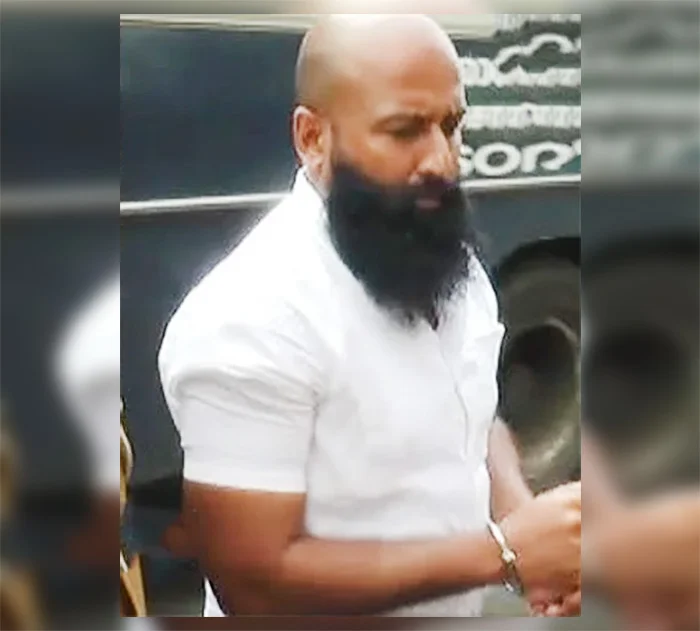
Against the backdrop of Public Security and Parliamentary Affairs Minister Ananda Wijeyapala’s declaration in Parliament of a nexus between the underworld and some sections of the administration, particularly the police, Pubudu Jagoda of the Frontline Socialist Party (FSP) demanded to know as to why Ganemulle Sanjeewa
IGP Priyantha Weerasooriya
had been produced in court on February 19 without a court order. The FSP spokesman emphasized that the crux of the matter is why he had been brought to court in the absence of a court directive and despite there having been specific intelligence that an attempt was to be made on the suspect’s life on that day as disclosed by Acting IGP Priyantha Weerasooriya at a hastily called media briefing at the Information Department over the last weekend.
By Shamindra Ferdinando
Two shootings at Kadewatte junction, Middeniya, on Tuesday night (18), and at the Colombo Hulftsdorp Court complex, the following day, quite conveniently deprived Parliament of an opportunity to conduct a proper debate on President Anura Kumara Dissanayake’s first Budget delivered on February 17th. The reportage of the Budget debate proved that it was a non-event as it was overshadowed by the audacious killing of Ganemulle Sanjeewa as he stood in the dock of the Hulftsdorp Magistrate Court number 05.
The Middeniya shooting claimed the lives of three persons – Aruna Vidanagamage aka Meegas-are Kajja, 39, and his six-year-old-daughter and nine-year-old son. Vidanagamage captured public attention recently when the gangster, in a no holds barred interview with Chamuditha Samarawickrema in ‘Truth with Chamuditha,’ accused the Rajapaksa family and some of its henchmen of criminal activity. Vidanagamage alleged that a person (who was named), close to the Rajapaksas, had given a contract to kill him though he didn’t believe the family was aware of the move.
A policeman, attached to the Tangalle Police, is among the three persons who have been so far taken into custody in connection with the Middeniya triple killings. However, the police constable hadn’t been apprehended for his involvement with the killing but for giving two pairs of handcuffs that were found at the scene of the shooting that had been given to “Kajja” earlier by him. The unauthorized transfer of handcuffs to a criminal by a cop underscored the gravity of the situation. The revelation reflects the overall deterioration of law enforcement. Recently, another cop, attached to the Mount Lavinia Police, gave his service weapon to the drug underworld and escaped to Dubai.
The Hulftsdorp shooting that claimed the life of Sanjeewa Kumara Samararathne, alias Ganemulle Sanjeewa, sent shock waves through the inept law enforcers. The killing inside the No. 05 Magistrate’s Court and the arrest of the gunman under controversial circumstances highlighted the deficiencies in overall law enforcement.
Ganemulle Sanjeewa, who had been arrested on Sept. 13, 2023, at the Bandaranaike International Airport (BIA), on his arrival from Nepal, was the second person in custody to die in a hail of bullets inside a courtroom.
The Opposition, in an obvious bid to exploit the developing situation, claimed a breach of national security. The National People’s Power (NPP) was accused of jeopardizing the security of the state. The government dismissed that assertion while claiming the Hulftsdorp shooting as an isolated incident. The actual truth lies somewhere in between with widespread despicable behaviour of law enforcers all over the country, with corrupt cops being brazenly involved in lucrative underworld businesses, especially in facilitating and milking the deadly narcotic trade. Some Opposition lawmakers called for Public Security and Parliamentary Affairs Minister Ananda Wijepala’s resignation. The Jathika Jana Balawegya (JJB) would have done the same if some other party wielded political power now.
A member of the main Opposition Samagi Jana Balawegaya (SJB) compared the Hulftsdorp security lapse with that of the 2019 Easter Sunday carnage. SJB lawmaker Rohana Bandara’s appraisal is obviously a case of going overboard. The Sri Lanka Podujana Peramuna (SLPP) and the National Democratic Front (NDF), too, attacked the Budget calling it an IMF product.
The first courtroom killing took place during Chandrika Bandaranaike Kumaratunga presidency. Before we discussed that high profile killing of notorious underworld figure Dhammika Amarasinghe on a Friday morning in early January 2004, at the Colombo Chief Magistrate’s court, in the same court complex as last week’s brazen killing of a notorious suspect Sanjeewe, as he stood in the dock, by an Army deserter Chaminda Udaya Kumara, 28. It goes without saying the responsibility on the part of the armed forces to tighten up discipline and recruiting procedures is utmost, especially now long after the earlier debilitating terrorist threat, as there is no longer any necessity to absorb anyone who turns up for recruitment as the forces are no longer desperately short of manpower to fight a debilitating war like earlier against the world’s deadliest terrorist force with a conventional fighting capability.
Assassin Chaminda Udaya Kumara, responsible for the 2004 killing, entered the courtroom as a law student. In the latest such daring killing last week, the gunman disguised himself as an Attorney-at-Law.
Chaminda Udaya Kumara had been apprehended in the record room where he was overpowered by a Lance Corporal of Sri Lanka National Guard (SLNG) and handed over to the police. On both occasions, the assassin hadn’t been subjected to checks. It would be pertinent to mention that Dhammika Amarasinghe’s assassin had made an attempt to escape by taking a person hostage and opened fire causing injuries to two persons before the SLNG soldier swung into action.
Ganemulle Sanjeewa’s killer had joined the Army 12 years after the successful conclusion of the war against the Liberation Tigers of Tamil Eelam (LTTE). Therefore, he hadn’t served the then Lt. Gen. Sarath Fonseka’s war-winning Army. Although some speculated that the assassin had joined the Army as a Muslim, inquiries, however, revealed that was not the case. Asked to explain, an authoritative officer pointed out that it wouldn’t be fair to identify the assassin as a commando as he had undergone only the basic course.
According to Army records the assassin joined the Army in 2020 and was legally discharged after he was found guilty of going AWOL (absent without leave) in 2023. Accused of using several identities, the assassin, immediately after his arrest at Palaviya, identified himself as Mohamed Azman Sherifdeen. At the time the Army discharged the assassin, he had been with the 3rd Commando Regiment.
The real identity of the assassin, born in 1997, is Samindu Dilshan Piyumanga Kandanaarachchi, a resident of Dambahena Road, Maharagama.
When did the assassin start using fake identities? How had he obtained a fake BASL ID? Who could have arranged the deadly mission? Let us once again emphasise that shortcomings on the part of the Army could have been ignored if such deceptions took place during the war as the military was desperate to double its strength but over a decade and a half after the war such lapses couldn’t be justified, under any circumstances.
First killing in a courtroom
Contract killer Dhammika Amarasinghe had been under investigation in a headline grabbing case involving the then Telecom and Sri Lanka Cricket (it was called Sri Lanka Cricket Board at that time) chief Thilanga Sumathipala, accused of funding the gangster as a guest of the SLC to watch the 1999 Cricket World Cup in the UK. Investigations revealed that the assassin, who travelled to the UK, allegedly on a fake passport, had received SLC funds to the tune of 1,500 Sterling Pounds.
Amarasinghe was to be produced in court on the following Monday to answer questions regarding the UK sojourn at the SLC’s expense. Sumathipala, who was to appear in court on Thursday, the day before Amarasinghe’s killing, didn’t attend court, claiming sudden illness.
At that time no one alleged it wasbreach of national security though it was a highly politicized case. However, Dhammika Amarasinghe was taken out inside a court when produced before it over two murder cases – one at Borella and the other at Welikada. Before Dhammika Amarasinghe’s killing, his rivals killed 16 of his relatives.
Investigations revealed that the gunman had been in the same court when Dhammika Amarasinghe was produced in court pertaining to Thilanga Sumathipala’s case on the previous day.
The assassin claimed that he took out Dhammika Amarasinghe to avenge the killing of Dhanushka Perera aka Baddegane Sanjeewa of the Presidential Security Division (PSD).
Then President Kumaratunga’s security chiefs accommodated notorious gangster Baddegane Sanjeewa in the PSD and issued him an official weapon. Unfortunately, he hadn’t been the only ruffian taken to the PSD during her tenure as the President. President Ranasinghe Premadasa is believed to have absorbed notorious gangster Soththi Upali to the police reserve as a Sub Inspector.
Investigations revealed that Baddegane Sanjeewa’s assassin travelled with him in the luxury vehicle when he was shot from the back seat. Investigations also revealed that at the time the PSD thug had been shot he was on his mobile with Venessa Selvaratnam who earned significant media coverage over the killing of Papua New Guinean ruggerite Joel Pera inside a casino in a case that also allegedly involved the late Minister Anuruddha Ratwatte’s son Lohan. The killing of the PSD hoodlum took place at a cross street, off Pagoda Road, in Nugegoda.
In spite of accusations that Baddegane Sanjeewa carried out a spate of attacks, including the killing of Sinhala tabloid editor Rohana Kumara, the then SLFP-led People’s Alliance (PA) simply ignored complaints. The notorious PSD cop was killed at the height of his political influence. Rohana Kumara, who carried out a relentless campaign through his newspaper, targeting President Kumaratunga’s administration, was shot dead on the evening of Sept. 07, 1999 near his Colombo home.
During Kumaratunga’s tenure, the PSD also attacked popular singing couple Rookantha Goonetilleke and Chandraleka Perera after invading their home in the presence of their children, at Mattegoda, in January 2000. Ten officers were found guilty of the dastardly act and ordered, in 2013, to pay Rs 200,000 compensation each to the two victims and also sentenced to four and a half years imprisonment, but they were granted a presidential pardon in 2014.
A budget aligned with IMF
There hadn’t been a previous occasion when a government presented a budget totally in line with dictates of the International Monetary Fund (IMF) though there were numerous agreements/understandings between successive governments and the Washington-based lending bodies.
President Dissanayake, in his capacity as the Finance Minister, revealed in Parliament what his government had agreed with the IMF. There is no doubt Finance Secretary Mahinda Siriwardana and Governor of the Central Bank Dr. Nandalal Weerasinghe played quite significant roles in keeping the country in line with the IMF’s agenda.
Regardless of a section of the Opposition condemning President Dissanayake for adhering to IMF dictates, it would be pertinent to mention that the Parliament, in July last year, endorsed the Economic Transformation Bill (ETB) without a vote. The Parliament reached consensus on that unprecedented Bill to ensure that the country remained committed to the four-year-long IMF programme, finalized on March 20, 2023 during the previous Wickremesinghe regime.
SJB leader Sajith Premadasa, SLPP National Organizer Namal Rajapaksa, as well as a spokesperson for the New Democratic Front (NDF), was backed by former President Ranil Wickremesinghe. The five-member NDF parliamentary group, comprising ex-SLPPers and ex-UNP Minister Ravi Karunanayake, should explain why they accepted the ETB without a vote. In terms of the four-year Extended Fund Facility (EFF) arrangement, the IMF approved SDR (Special Drawing Rights) 2.3 bn (about USD 3 bn).
The SJB and SLPP shouldn’t play politics with the issues at hand as both parties are equally responsible for the economic decline caused by long-time mismanagement of the national economy. The SJB conveniently forgets that it had been part of the UNP, during Yahapalanaya, and cannot, under any circumstances, absolve itself of the responsibility for the Treasury bond scams, perpetrated in Feb. 2015 and March 2016, and issuance of USD 10,000 mn in new ISBs (International Sovereign Bonds) between 2015 and 2019 by that treacherous administration, comprising the UNP and the SLFP. New ISBs debilitated the economy. That is the ugly truth. And as to what they did with that money and the USD 1.2 billion they got by leasing out Hambantota International Port to the Chinese on a 99-year-lease, is anybody’s guess. Surely the country’s assets did not increase during the tenure of that government by any stretch of our imagination to show for such influx of US dollars.
At the time Mahinda Rajapaksa had been voted out in January 2015, the outstanding ISB debt was only USD 5,000 mn. The Gotabaya Rajapaksa government (2020-2022) had paid off USD 2,500 million in outstanding ISBs, which meant that only USD 2,500 million in ISBs remained at the time Yahapalanaya took over in 2015.
But when the US-backed Aragalaya overwhelmed the Rajapaksas, they invited the man who oversaw Yahapalanaya, economic strategy Ranil Wickremesinghe, to save their skin. No less a person that former President Mahinda Rajapaksa is on record as having said that taking ISB’s amounting to USD 10,000 mn broke the back of the Sri Lanka’s economy. Then why on earth the person who caused that destruction was invited to accept the premiership in May 2022 and then elected President in July through a vote in Parliament. All in fear of deranged or highly drugged mobs unleashed during Aragalaya as was the case later in Bangladesh. But the Aragalaya marauding mobs, who were threatening to die for a system change, just vanished into thin air once Ranil Wickremesinghe was installed in the seat of power. How convenient?
The SLPP shouldn’t find fault with President Dissanayake for adhering to a Bill that received the blessings of all political parties, as well as breakaway factions, represented in Parliament. There cannot be a better example than the dissident SLPP group, led by Prof. G. L. Peiris and Dullas Alahapperuma, as they, too, endorsed the ETB by conveniently backing the decision to go ahead without a vote.
The SLPP that won 145 seats at the 2020 August general election had been reduced to just three lawmakers, including one National List slot, at the last general election. Unfortunately, the party hadn’t yet understood why the electorate dealt with the party so harshly. It should take remedial measures to rebuild the shattered image and attract the public again.
A far worse security breach
The JVP, now in power, caused, perhaps, far worse security breach than the killing of Ganemulle Sanjeewa, though none of the political parties, seeking to take advantage of the developments, failed to mention the JVP bid to wipe out the top UNP leadership in August 1987.
The writer was at The Island editorial on the morning of August 18, 1987 when a JVPer lobbed two hand grenades at the UNP parliamentary group meeting in Committee Room A at the Parliament building. The near simultaneous blasts targeted about 120 MPs present at the meeting, the first group meeting after the signing of the Indo-Lanka accord on July 29, 1987. President J. R. Jayewardene presided over the meeting. Premier Ranasinghe Premadasa was present. Luckily for the UNP, the blasts caused injuries to several lawmakers but only Matara District MP Keerthi Abeywickrema succumbed to his injuries. The writer, having joined The Island just two months before, covered that funeral in Matara held under heavy security as the then government feared the JVP would launch an indiscriminate attack. It was the second killing of an MP by the JVP, following the deployment of the Indian Army in the northern and eastern provinces in terms of the so-called peace accord that was forced on Sri Lanka to halt ‘Operation Liberation’ carried out in the Vadamarachchy region of the Jaffna peninsula.
Later, the police identified the attacker as R.M. Ajith Kumara, an employee at the Parliament after he was arrested at Akaranduwa, Naula, on April 08, 1988, during a raid on an illicit liquor den. The chance and subsequent interrogation of the suspect revealed him as the man who planned the mass murder of lawmakers.
Ajith Kumara and four others were charged with carrying out the August 18, 1987, grenade attacks on the UNP parliamentary group. However, the Colombo High Court at Bar, on Oct. 12, 1990, delivered a unanimous verdict acquitting Ajith Kumara. Delivering the verdict, High Court Judge Ananda Grero declared that the prosecution had not proved the charges beyond a reasonable doubt.
Declaring his allegiance with the JVP, Ajith Kumara entered politics and was later accommodated in the JVP politburo. Ajith Kumara served as a JVP Pradeshiya Sabha member and years later contested Sabaragamuwa Provincial Council poll as the JVP’s Chief Ministerial candidate. The rest is history.
Midweek Review
Will AKD’s ‘Glasnost and Perestroika’ moment redefine Sri Lanka’s destiny?
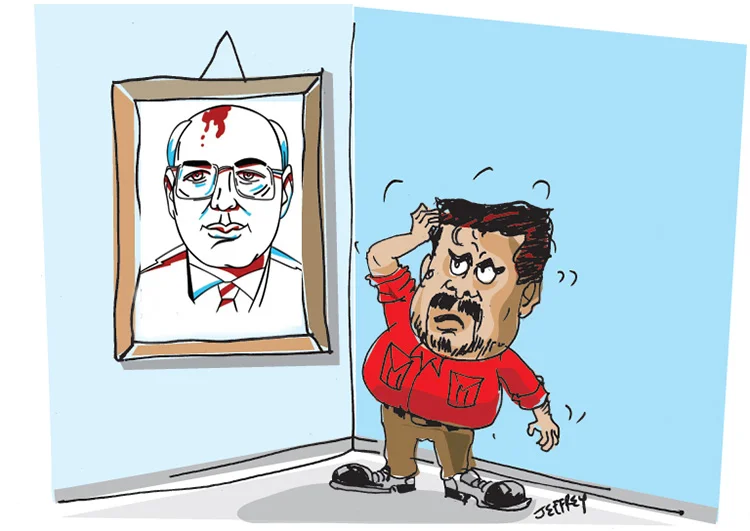
By Gamini Jayaweera
In 1985, former Soviet leader Mikhail Gorbachev, who assumed the presidency of the USSR, sought to reform the Soviet Union’s centrally planned economic system, which had been stagnant for several years. He recognised that the rigid one-party rule political system, including its politicians, was plagued by corruption, the workforce was inefficient, technology was outdated, and citizens struggled to access basic goods and services. Additionally, democratic rights for the people and the media were severely restricted. All of this was occurring under a communist system of government in a vast nation.
Gorbachev’s attempt to reform Russia’s struggling economic, social, and political systems through his Glasnost (openness) and Perestroika (restructuring) initiatives failed. This was largely due to resistance from the Central Committee of the Communist Party, which was dominated by hardline communist ideologists opposed to Western-style economic and political reforms. This resistance, combined with a failed coup, ultimately weakened Gorbachev’s authority, paving the way for Boris Yeltsin, whose neoliberal reforms transformed Russia’s political landscape.
Decades later and thousands of miles away, Sri Lanka faces its own political, economic, and social challenges. President Anura Kumara Dissanayake (AKD) and his coalition, the National People’s Power (NPP), rose to power amidst a bankrupt economy, decades of political corruption, a largely inefficient and overstaffed state workforce, use of outdated technology, and mounting debts hindering development. Despite operating within a democratic system, the underlying challenges appear strikingly similar to those faced by Gorbachev, highlighting a parallel between the two countries’ governance mechanisms, but one under communism and the other under the guise of democracy.
AKD is pursuing his economic policy to balance socialist welfare programmes with capitalist economic reforms to revive the economy. Like Gorbachev, AKD’s reforms aim to modernise the Sri Lankan economy without abandoning socialism. The introduction of limited market reforms, decentralising economic control, and encouraging private enterprise may undermine the central authority of the leftist Janatha Vimukthi Peramuna (JVP) which control the lion share of the NPP coalition, leading to political instability and the rise of nationalist movements within Sri Lanka.
However, the political dynamics, including resistance from extreme left-wing factions and right-wing opponents, could determine the outcome of AKD’s ambitious agenda. While history does not necessarily repeat itself, the spectre of political instability remains a concern.
AKD’s “Glasnost and Perestroika”
Creating “A Rich and Beautiful Country” is the bold and inspiring vision articulated by the newly elected President and the parliamentary members of the National People’s Power (NPP) government, as detailed in their manifesto and policy documents. The President of Sri Lanka, a charismatic and inspiring leader of the NPP, recently delivered a heartfelt and enthusiastic address to parliament and the nation.
In his address, he outlined his ambitious vision and expectations for steering our country onto a path of sustainable prosperity. Delivered without the aid of written notes, his speech was a commendable demonstration of his dedication and sincerity. As Sri Lankans, we take pride in the President’s energy and unwavering commitment to turning his vision into reality.
However, this vision, no matter how inspiring, faces critical challenges. Can the NPP government translate the ambitious goals outlined in their policy documents and the President’s impassioned words into tangible outcomes? Achieving such a transformative vision requires a meticulous and coordinated effort, along with all the necessary components to overcome the significant hurdles ahead.
My focus here, rather than attempting an exhaustive analysis, is to highlight a few pressing concerns that demand immediate attention in order to secure the success and integrity of this transformative journey of achieving “Glasnost and Perestroika.” As a hopeful Sri Lankan committed to systemic change, I wish to underscore these concerns within the NPP administration that could impede our collective vision for progress.
NPP Leadership
Effective leadership is the cornerstone of good governance, guiding nations towards progress and stability. In the context of the NPP government, the transition from trade union advocacy to ministerial leadership presents unique challenges and opportunities.
The President and the Cabinet hold the highest level of leadership in the government, serving as the architects of national direction and policy formulation. They entrust the heads of departments with the responsibility of implementing these policies through their ministerial secretaries. However, effective leadership demands clarity and unity. If Ministers and their Secretaries fail to provide a cohesive and unambiguous direction to the department heads within each ministry, the result will be organisational chaos. This challenge is particularly relevant given the leadership background of several ministers in the NPP government.
Several ministers in the NPP government were formerly trade union leaders before their recent appointments to ministerial positions. While their prior roles involved leading, advocating, and vigorously championing the demands of the workforce, particularly in the public sector, ministerial responsibilities require a fundamentally different approach. Administering and addressing the needs of the workforce as the primary representative of the government, which acts as both the “Owner” and “Financier” of public organisations, demands a much more nuanced and balanced perspective.
An assertive, advocacy-driven leadership style must evolve into a more balanced approach that considers the needs of all stakeholders. Without adopting this more inclusive mindset, ministers risk alienating sations, thereby jeopardising the systemic changes, and both short and long-term progress envisioned by the President. So far, we have witnessed some ministers who were affiliated with trade unions in the past not having transformed their new roles to act impartially to unite the management and the workforce in their ministries.
It is also important to acknowledge that this cabinet includes ministers who embody these balanced leadership qualities. The President, along with other senior and experienced ministers, must take the lead in mentoring and guiding the younger, energetic, but less experienced members of the team. By providing direction and fostering a collaborative environment, they can ensure that public expectations are met, and the government stays on course toward achieving its overarching goals.
Humility and credibility
Since the inception of NPP’s governance, a recurring and concerning pattern has emerged among certain ministers, a belief in their own infallibility and a persistent perception that the opposition is perpetually wrong. This mindset not only risks stifling constructive debate but also undervalues the diverse experiences, skills, and ideas that others bring to the table.
A similar tendency can be observed globally, where some politicians treat their political ideologies as the ultimate truth, often dismissing differing perspectives. This approach fosters polarisation and inhibits meaningful collaboration. Within the NPP leadership, it is essential to recognise that, no matter how diligently they work, the attitudes and behaviours of the leadership team can significantly hinder progress.
True leadership demands humility, an often-overlooked quality that is far from a weakness. Instead, humility forms the cornerstone of effective leadership, helping to build trust, foster collaboration, and ensure sustainable success. By embracing humility, leaders can create an environment where diverse viewpoints are valued, and progress is achieved through collective effort.
Integrity among Ministers is essential for gaining the trust and recognition of the public. During the former Speaker’s qualifications controversy, the Opposition justifiably announced plans to bring a no-confidence motion against him for dishonesty.
A Minister who was previously a Trade Union leader, publicly dismissed the motion without examining the facts or acknowledging the embarrassment caused to the NPP government. Such statements demonstrate blind loyalty to party colleagues, lack of experience, responsibility, caution, and trade union mentality. The President, in contrast, declared that “wrongdoing would not be tolerated regardless of rank or position,” a stance that led to the Speaker’s resignation. This demonstrates decisive leadership and a commitment to accountability, qualities that others in government should emulate.
The inexperienced, young Minister in question would do well to take a page from the President’s book. Credibility and integrity, once lost, are nearly impossible to regain. Leaders must exercise care and responsibility when commenting on matters of public concern.
So far, no action has been taken for the allegations that some Members of Parliament from the NPP and the Opposition have given misinformation about their educational qualifications during the election campaigns. It is crucial for the President or the Leader of the House to address these claims promptly to prevent further distractions and maintain public trust.
Cultural Changes and Motivation
Culture is not a “soft” subject, yet most political leaders and public sector organisational heads treat it as if it were. Culture embodies the behaviours of employees and the infrastructure of the organisation. It is the foundation on which success is built.
Driving cultural change is no easy task. A key strategy is to provide comprehensive training that fosters employee engagement and ownership. Sustainable change hinges on behavioural performance, reinforced by a structured system of incentives, support, and motivation.
It cannot be transformed merely through lofty speeches extolling the “honesty” of the ruling party, especially when directed at workers in the public sector. Similarly, continually decrying the “dishonesty” of previous regimes does little to foster meaningful change. Leaders in the NPP should avoid complacency regarding their reputation for “honesty,” as their tenure in government is relatively brief and largely untested.
Importance of the human touch, education, and motivation in achieving success,
especially when tackling complex challenges is essential. There are no quick fixes when it comes to changing human behaviour. Organisational transformation is a gradual, deliberate process, but one that is essential for cultivating a high-performing, responsive public sector which is a major part in the System Change.
Govt. Tender Process
A recent parliamentary debate exposed concerns over the Mannar Wind Farm Project’s tender process. Despite the Tender Evaluation Committee (TEC) and Procurement Appeal Board (PAB) recommending the disqualification of two non-compliant companies, the new Energy Minister annulled the initial process, introduced a fresh tender process, and awarded the contract to an originally rejected bidder. The Minister claimed the new contract was cheaper.
This raises serious concerns about political interference in Sri Lanka’s renewable energy sector. As a professional with nearly 40 years of experience in construction spanning Procurement to Final Accounts in the UK and Sri Lanka, I find this deviation from proper tendering procedures deeply concerning.
A professional tender evaluation considers not just cost but also technical capability, organisational strength, commercial factors, health and safety standards, and relevant experience in similar projects. Low initial bids can often lead to escalated costs through variations and claims, ultimately exceeding the most economically advantageous bid.
If the Minister prioritised cost alone, a direct negotiation with a local contractor would have been more transparent, avoiding wasted public funds and unfair costs to other bidders. This incident casts a serious shadow over the NPP’s commitment to integrity and fair play in the tendering process, raising critical questions about accountability in public procurement.
Conclusion
While the NPP government has been in power for nearly six months, it is understandable that the public’s expectations and scrutiny are high. The trust and hope that the Sri Lankan people have placed in the NPP come with heightened vigilance, as even the smallest misstep by the new administration could be seen as jeopardising what many view as the nation’s last chance to set a sustainable course for the future.
The path to reform will undoubtedly be challenging and fraught with obstacles. Yet, it is a journey we must undertake, not only to honour the hopes of the present but to secure a brighter future for generations to come. It will be interesting to witness the successful implementation of Sri Lanka’s version of AKD’s “Glasnost and Perestroika,” especially since the originator of this concept, former Soviet leader Mikhail Gorbachev, faced significant challenges and ultimately did not achieve his intended outcomes three decades ago.
However, for AKD’s vision to succeed, it is crucial for all citizens to actively support but demand accountability from the President and his Cabinet as they navigate this difficult transformative phase. Their leadership will be vital in uplifting the economic, social, legal, and political systems while enhancing democracy as the foundation for realising Sir Lanka’s own “Glasnost and Perestroika.”
Midweek Review
Market Place Tremors
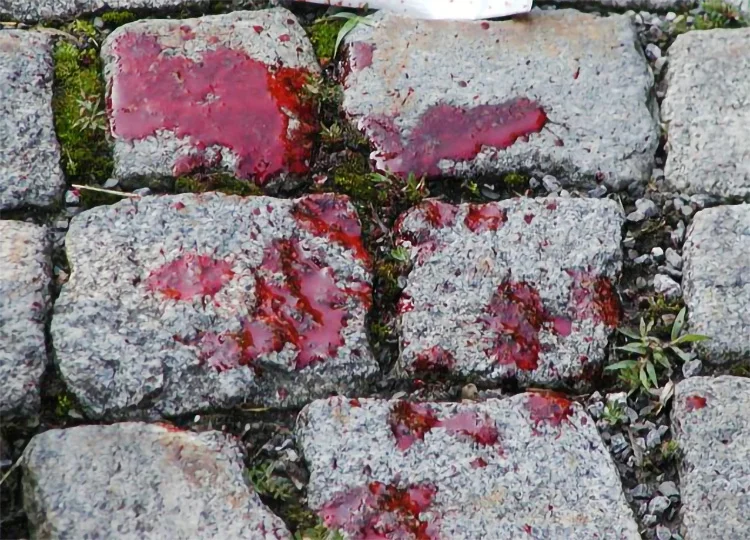
By Lynn Ockersz
He was your regular breadwinner;
Doing his daily routine, prayer-like,
Rushing through his scrap breakfast,
And setting off for state sector chores,
His little daughter on his scooter’s pillion,
He yelling to his wife busy in their back yard,
That he would be picking up the ‘small one’,
At her teeming tuition class that evening,
But as shadows lengthened at day’s end,
They found him sprawled out in a pool of blood,
On a suburban pavement some distance away,
Seemingly, an unintended victim of a paid killer,
But let none look askance at these happenings,
For, when the purses of some folks begin to pinch,
They begin to submit to the market’s dictates,
Which lead them into quite irregular byways.
-

 Business3 days ago
Business3 days agoSri Lanka’s 1st Culinary Studio opened by The Hungryislander
-
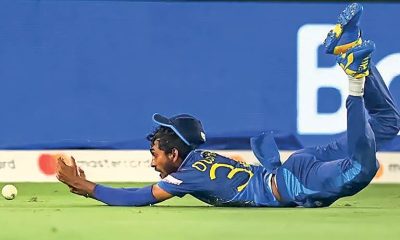
 Sports4 days ago
Sports4 days agoHow Sri Lanka fumbled their Champions Trophy spot
-
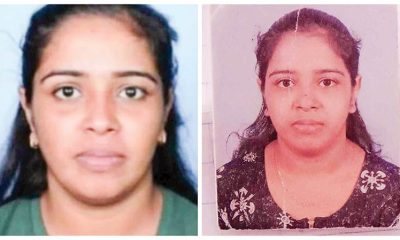
 News6 days ago
News6 days agoKiller made three overseas calls while fleeing
-
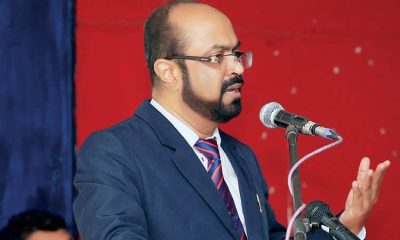
 News5 days ago
News5 days agoSC notices Power Minister and several others over FR petition alleging govt. set to incur loss exceeding Rs 3bn due to irregular tender
-
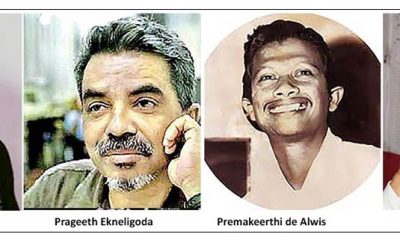
 Features4 days ago
Features4 days agoThe Murder of a Journalist
-
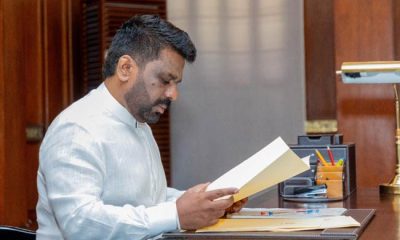
 Features4 days ago
Features4 days agoExcellent Budget by AKD, NPP Inexperience is the Government’s Enemy
-
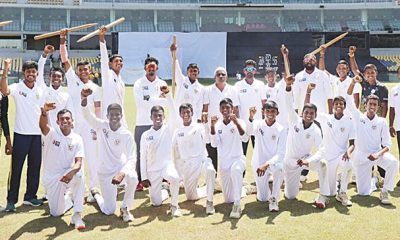
 Sports4 days ago
Sports4 days agoMahinda earn long awaited Tier ‘A’ promotion
-

 News5 days ago
News5 days agoMobile number portability to be introduced in June


